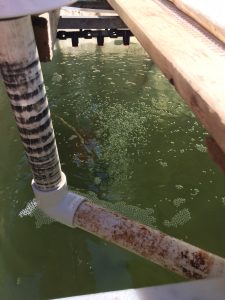Last updated on June 25, 2018
The first air-line goes to the front left bottom of the IBC fish tank. It is connected to a 10cm / 4in air-stone, sitting on the bottom. Of primary importance here is that DO is being added at the bottom of the tank, making sure that the bottom of the tank does not be

come a low-DO / anaerobic zone. The fish have an area of the tank where they can get a breath of fresh air at all times at all depths in the water column. Even with the valves being throttled back to about 25% per line, that is more than eight litres of air being injected into the system, which amounts to about 2L of O2 being added every minute. Rainbow trout are comfortable with DO levels above 100ppm; that is roughly 1L of O2 for a 1000L IBC. In other words, I expect that I’m easily keeping things safe for my fish.
This creates a column of bubbles rising from the bottom of the tank, lifting the water around it upwards. The “mushroom head” where the bubbles hit the surface is more than 15cm / 6in across, so the volume of water being lifted is significant.
This ensures that the tank “rolls” vertically. The rising water creates a low-pressure area around the air stone and bubble column, pulling more water near the bottom of the tank towards the bubbles. I expect that every three to four hours, this action essentially turns the tank upside down, preventing the water from stratifying.
The second air hose runs down the inside of the Solids Lift Overflow (SLO) pipe, and connects to a 15mm x 25mm (0.6in x 1in) barrel-shaped air-stone. Running at about the same air-flow rate as the other line, it effectively transforms the SLO into an air-lift pump. This ensures that there is good suction in the SLO for lifting waste material off the bottom of the tank. It also ensures that all the water coming out the bottom of the IBC fish tank and flowing into the Heavy Solids Settling Tank (HSST) is very well oxygenated. This should prevent the HSST from becoming a low-DO / anaerobic environment as the solids at the bottom of the tank decompose.
Obviously, the SLO needs a gravel-guard / fish-screen on the end of the pipe near the bottom of the tank. Otherwise, the 10 – 20LPM air-lift suction might well slurp up a sleeping fish. I do not want to be trying to get a fish out of a 50mm / 2in pipe, or out of my HSST.
Be First to Comment